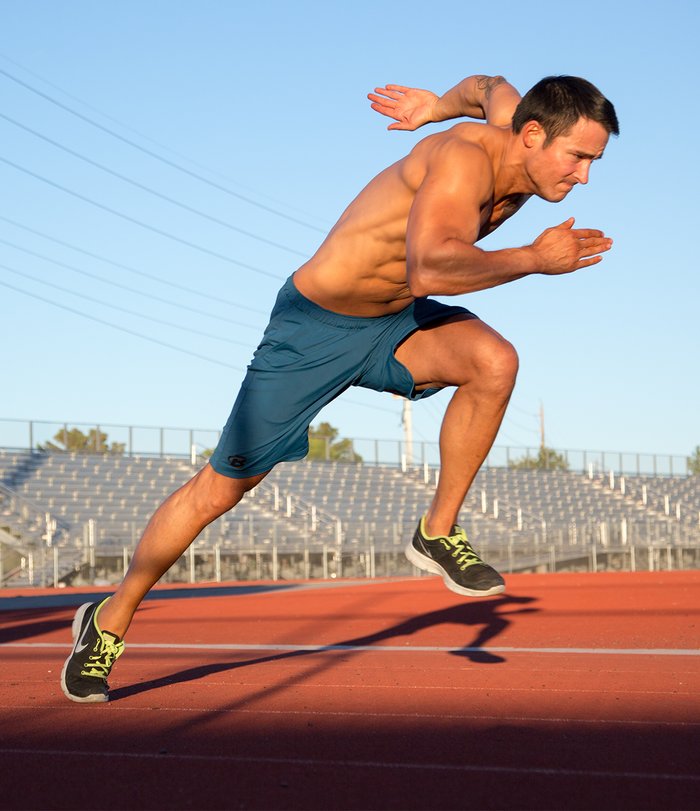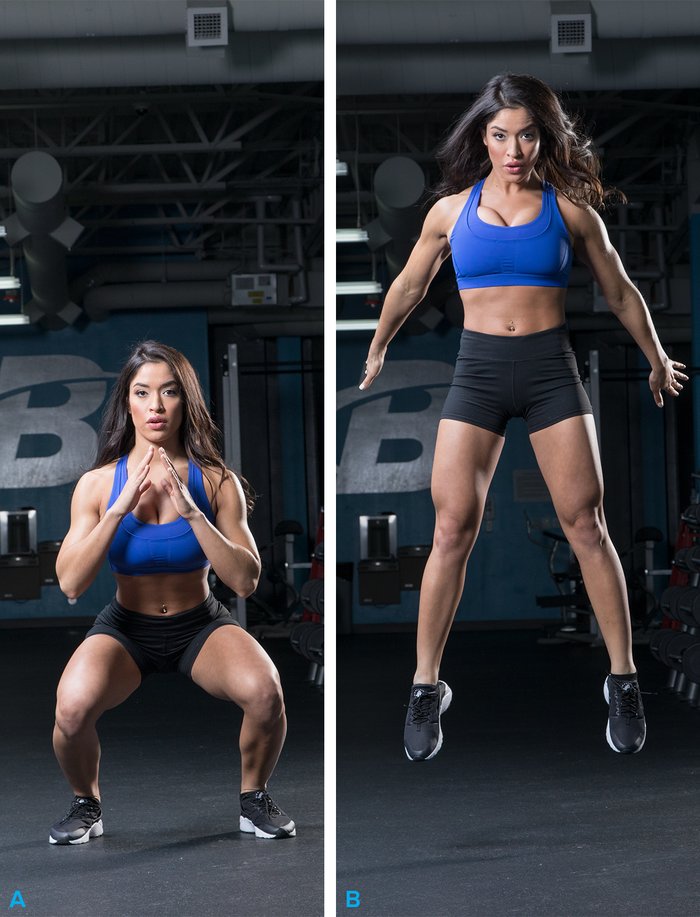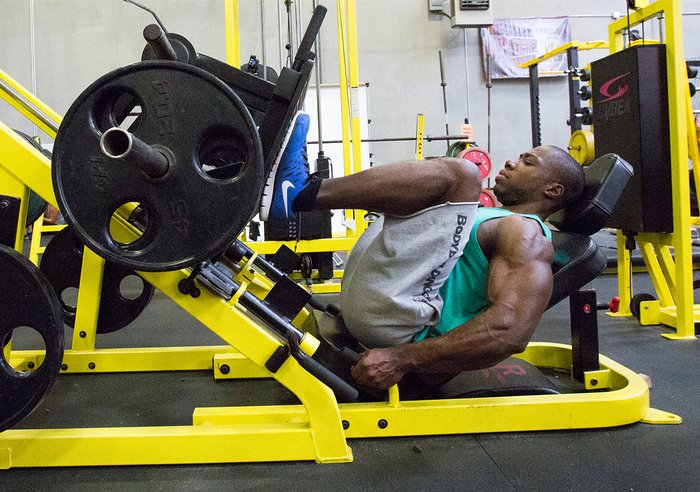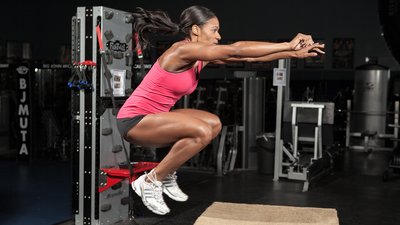Athletes today are bigger, faster and more explosive than ever before. Everyone wants to be able to run faster and jump higher, so why is there so much confusion about how to train athletes? Why does one group of strength coaches tell you to lift heavy weights, another tells you to lift light and fast, and others tell you to only use Olympic lifts?
And they each tell you the same thing, "If you lift our way you will become more explosive." Most of this confusion comes from a failure, by both coaches and scientists, to develop a theoretical framework for training athletes. This framework could be used to explain why some exercises and training methods are more successful than others.
Instead, we have numerous studies that give conflicting arguments and findings. This confusion has led the strength coach to develop training methods based on trial and error. Thus, strength coaches usually tend to drift toward one of these three directions, which is a shame because athletes benefit from each of these types of training.
Another frustration for the strength coach is our inability to standardize basic words and definitions. "Explosive" and "power" are terms often used in exchange for each other. These two terms are related, but can be trained separately and are not always dependent on each other.
Many athletes are explosive, but at the same time lack power. On the other side, an athlete can be powerful, but lack explosive strength. Power output is affected by the speed of movement. By performing movements faster you can increase power, but explosive strength may not necessarily be affected by movement speed.
Conversely, explosive strength is affected by the speed of contraction, regardless of movement speed or the type of contraction. Explosive strength can be high in a contraction where no movement (isometric) is taking place. The distinction between speed of movement and speed of contraction will help clarify power and explosive strength.
Strength and conditioning studies usually focus on training methods and exercises that affect either explosive strength or power measures.[1,2] These measures are tested to see if there is a relationship (correlation) with sprint and jump results.
The inherent problem with this type of research is that these measures are compared against each other instead of examining their combined (synergistic) effects. A better approach might be to examine the exercises and training methods that develop a larger number of athletic measures.
As we will see, power and explosive strength must be assessed, understood and developed for an athlete to reach their full potential. Increases in both speed of movement (effects power) and speed of contraction (affects explosive strength) would be beneficial for any athlete regardless of skill level, sport or weight of external load.

Fast movements such as sprinting and rapid jumps typically involve contraction times of 50-250 milliseconds.
Explosive Strength
In sports, athletic movements need to be performed at high speeds. Fast movements such as sprinting and rapid jumps typically involve contraction times of 50-250 milliseconds.[3] This presents a problem: it takes a longer time (>300ms) for muscle to develop maximum force. Since maximum force cannot be developed with fast movements, any increase in the rate of force developed in the early phase of contraction becomes vital.
Explosive strength is defined as the rate of force development (RFD) at the onset of contraction.[4] RFD is taken from the slope of the Force-Time curve (see Fig. 1). The goal of training for improved RFD is to shift this curve to the left (i.e. create more force in less time). In an isometric contraction (no movement), force can be developed quickly, therefore RFD can be high.
RFD is not dependent on the speed that the segments (trunk, upper leg, lower leg) travel. But, RFD has an important role in fast movements; it allows maximum force to be developed earlier. The increase in RFD is considered one of the most important adaptations elicited from resistance training.[5]
In some cases, RFD will be sacrificed for increases in movement of speed. This can be illustrated by looking at the affects of a countermovement on a vertical jump. Two jumps will be performed:
- a concentric-only jump, where the athlete gets into a half-squat position, then pauses, and performs only the pushing up phase of the jump.
- a regular vertical jump, where the athlete first bends down (countermovement) and then jumps upward in one motion.
The first jump (concentric) is performed fast, where maximum force cannot be developed, but RFD is high. In the second jump (countermovement), the upper body creates an additional downward force during the countermovement. This downward force causes the contraction speed of the muscles to slow down.
Thus, the muscles have more time to create maximum force, which increases the speed of movement.[6] In this example RFD is decreased in order to increase movement speed. If both RFD and speed of movement can be increased with training, performance will be enhanced significantly.
Power
We've all seen the definitions for Power, but many times they are not fully understood. Power equals Work/Time, and Work is the product of Force multiplied by Distance. Now, what's important in this equation is the distance. The farther the distance a segment (trunk, upper leg, lower leg) travels, the greater the Work and therefore, the greater the Power.
By comparing two types of vertical jumps, we will be able to see how increasing a distance can effect power. One jump will be initiated from a half squat position and the other from a full squat position. If the time it takes to perform the jumps is the same, the jump initiated from a full squat position would create more power since the segments travel a greater distance.

Vertical Jump: Full Squat Starting Position
In contrast, an isometric contraction of the knee joint will produce low power output since the segments are not traveling any distance. The speed of movement and power outputs would be low in this example, but RFD and explosive strength could be high if the effort is maximal. An increase in either distance or speed of movement will increase power.
Going back to the examples of the countermovement and concentric vertical jumps we will be able to examine the affects of movement speed on power output (see Table 1). In the concentric only jump, the speed of contraction is high, but speed of movement is low, therefore power will be low. In the countermovement, the speed of contraction is low, but the speed of movement is high, therefore power will be high.
Increasing power output is also considered one of the most important adaptations elicited from strength training. As an athlete sprints or jumps, a large force is created in a short amount of time as the segments travel a certain distance. Force, distance and time are products of power and can be changed in a positive way with resistance training. Again, both power and explosive strength must be considered by the athlete and coach.
Pre-Working State
The initial state of the muscle before contraction has a great impact on explosive strength and power. Muscle contraction begins with the muscles in one of four initial states:
- relaxed
- contracted
- dynamically stretched
- a "shock" stretch
An example of a relaxed pre-working state of the muscles could be a box squat.
With this exercise, you sit on the box and relax your hip flexors, then forcefully extend up. Your muscles are in a relaxed pre-working state since the box is supporting load and your body weight, not the muscles. In this exercise the RFD is high since force must be created from basically zero.
The traditional squat would be an example of a contracted pre-working muscular state. As you take the load on your shoulders the muscles support the load before you begin the lift. Most movements and traditional exercises (bench, curls and leg press) are initiated from a contracted pre working state.
In these examples, a great force can be created since the muscles are already in an active state before the movement. RFD will not be as high as the relaxed state, but force and power will be greater. An example of a dynamically stretched pre-working state is the vertical jump.
The countermovement dynamically stretches the muscle before the upward phase of the jump. This pre-working state can create a large amount of power, but RFD may not be as high. The "shock" method is utilized in fast stretch movements such as the depth jump.
This is an intense exercise and can be dangerous if not performed properly. These exercises produce the highest outputs of RFD and power. Each of these pre-working states should be implemented in training for the sprint/jump athlete.

Most movements and traditional exercises (bench, curls and leg press) are initiated from a contracted pre working state.
Exercises
So what does all this mean to the spring/jump athlete and coaches? Well, first it should be no surprise that at every athletic combine vertical jump and horizontal jump measures correlate highly with 40-yard sprint times. Eastern European coaches have been training sprint athletes with weighted jumps for many years.[7,8,9]
This type of training has taken some time, but is now starting to spread to the Western countries as well. Research studies are also in agreement that jumping and sprinting results are related. Weighted jumps that are initiated from different pre-working muscular states can improve explosive strength, power, or both.
In sprinting and jumping a force is created along with a fast movement. The goal of training is to increase both the amount of force developed in the early phase of contraction, and to increase the speed of the movement.
In order to increase an athlete's ability to sprint and jump, training must be specific to sprinting and jumping. Maximum force output, explosive strength and power will not help the sprint/jump athlete unless they are performed in relation to the mechanics and coordination of sprinting and running.
The exercises presented below are designed to increase explosive strength and power specific to these movements. Weighted jumps have similar speeds, angles and mechanics to sprinting and jumping, and have similar coordination patterns. The exercises in this article are not meant to be performed alone, but within the framework of a structured, periodized program.
I didn't include heavy exercises, high intensity plyometric or Olympic pull exercises (from the ground), which should be a part of any athlete's program. I did this because those exercises are more specific to the sport, time of season and your training philosophy.
Heavy lifts, Olympic lifts, and plyometic exercises will also increase explosive strength and power but are not as specific to sprinting and jumping as weighted jumps. Weighted jumps should be included in any training program designed for sprinting and jumping athletes. The exercises below could fit into any training program for any sport or athlete who needs to run faster or jump higher.
Demonstrations
1. Plate Jump
This exercise will allow you to jump harder than you may want. By forcefully swinging the weights forward, the weights end up pulling the body upward and forward. The body must match the speed of the weights otherwise you would fall over forward.
This exercise teaches you to jump harder and faster on each attempt. Make sure to reset before each jump. This exercise can be performed for height, distance, laterally, off a single leg, or with different amounts of weight.
Starting Position
Stand upright with a 10-pound plate in each hand. Execution: Swing the plates backward as you let your body bend downward in a countermovement.
Next, swing the plates forcefully forward and upward as you begin the jump. It's important to swing the plates all the way up to head level or higher. You can think of throwing the plates in front of you and letting the weight carry you. This exercise can be performed for 3 or 4 sets of 8-12 jumps.
2. Frog Squat Jump
This exercise works on switching from a slow eccentric contraction, to a fast and force full concentric contraction. The body will be forced to create a large amount of force in a short amount of time. A good variation for this exercise is to have the athlete close their eyes. This makes it harder to time when the dumbbell will touch the ground.
Starting Position
Stand upright while holding one end of a dumbbell with both hands. The dumbbell will hand with the free end facing downward.
Execution
On the descent let your arms relax and hang down. Squat back slowly, don't allow your knees to travel forward, keep your lower back flat.
The dumbbell will eventually touch the ground in between your feet, not in front of them. The touching of the dumbbell to the ground should be thought of as a trigger, once you feel this, jump straight up as fast and as hard as possible. Do not bend your arms during the jump. This exercise can be performed for 3-4 sets of 8-15 reps.
3. Box Squat Jump
This exercise is similar to how Louis Simmons has defined a box squat. The muscles are in a relaxed pre-working state at the beginning of the exercise. The body must overcome the weight and inertia of both the body and external weight. The box supports the weight of the body and dumbbell at the beginning of contraction, not the muscles.
A large amount of force is created from this relaxed position in a short amount of time. This exercise relies more on starting strength than the traditional box squat since the athlete actually jumps.
Starting Position
Place a dumbbell across your shoulders. The elbows will be facing straight ahead with the fingers on top of the dumbbell.
Execution
With the back of your heels placed against the box, sit way back onto the box. Do not round your low back on the box, keep a flat and tight lower back position. As you sit on the box relax your hip flexors, but keep everything else tight. From this position jump as hard and as fast as possible straight up.
Reset after each jump. Do not use a barbell for this exercise, with a barbell the elbows and arms are turned out and opened up. This is a quick jump and you want to keep the body tight throughout the jump. A barbell will put the body is a vulnerable position, we are not working with heavy weights and there is no reason to add a balance element to this exercise. This exercise can be performed for 3-4 sets of 8-12 reps.
4. Dumbbell Swing Threw Jump
This exercise is a combination of the DB Swing and the Pull Through. You get a big stretch of the posterior chain before a powerful hip extension. It's important to reach as far back as possible on the descent and to initiate the jump with the hips, not the arms.
Starting Position
Take a wider than shoulder width stance and hold a dumbbell in the same way as in the frog squat.
Execution
Swing the dumbbell down and backward between your legs, drop your head and reach as far back as possible. The jump is initiated by throwing the hips forward and up, let the weight lag behind. The extension of the hips will speed up the swing of the dumbbell.
As the dumbbell speeds up it will pull on the body similar to the plate jump. The last part of the jump will be sped up by the dumbbell pulling on the body. A large amount of force will be created during the late phase of the jump. This exercise can be performed for 3 sets of 6-10 reps.
5. Standing Triple Jump
Execution
This exercise is the same as the traditional triple jump except you do not have an approach. With a shoulder-width stance, start with a horizontal jump. Land on one leg, then jump forcefully forward. Next, land on the other leg and jump forcefully forward again, then land softly with both legs. Reset after each attempt.
This exercise can be used as a training exercise or as a test. It's a great measure of single leg power, much better than the single leg vertical jump or horizontal jump. This is a great exercise to prepare the body for bounds or depth jumps. This exercise can be performed for 2-3 sets of 4-8 reps.
6. Finger Clean
Starting Position
This exercise is just like the hang clean except it's performed with a finger grip. Hold the barbell with only your fingers, release your thumbs and open your hands. Stand up right with the barbell.
Execution
On the descent keep your knees in the same place. Do not allow the knees to travel forward, let the bar go straight down as the legs are pushed backward out of the way of the bar path. Let the bar travel down to the level of the knees, keeping the lower back flat. Now, forcefully extend the hips, knees and ankles, but do not allow the arms to lift or bend.
After full extension bend down, throw your elbows forward and up, catch the bar on your shoulders. The hands never close during this exercise, they start with the fingers holding the bar and end with the fingers under the bar.
This exercise does two things for the athlete. It teaches you to not use your arms to pull the bar up, thus the hips become responsible for getting the bar up. Once you begin lifting the bar with your arms, the brain sends more impulses to the arms and less to the hip muscles. So you end up lifting with the smaller and weaker bicep muscles instead of the bigger, more powerful hip muscles.
When learning the Olympic lifts you will be able to lift more weight with your arms than with your legs. So many people never learn to do these lifts with their legs and thus will plateau early. Once the body adapts neurally, the inter-muscular and intra muscular coordination will improve in the lower body and you will be able to lift heavier and heavier weight. This will not happen if you continue to lift with your arms and take the hips out of the movement.
Second, this is a great exercise for grip strength. For some reason grip training has been neglected recently. A strong grip is invaluable in many sports, especially explosive sports. Even more importantly a strong grip protects the elbow in overhead throwing movements. This exercise can be performed for 3-4 sets of 3-6 reps.
7. Dumbbell Jerk
Starting Position
Take a shoulder width stance and point the toes straight ahead. Hold each DB up to your shoulders with your elbows pointing straight ahead. Allow one end of the DB to rest on each shoulder.
Execution
Drop straight down a few inches and forcefully jump and extend up. Then, as quick as you can, drop straight down into a lunge position. One leg should go forward and the other goes straight back. Catch the weight with your arms fully extended in the bottom position. Stand up with the arms extended until you are upright, take small steps up. The arms should be fully extended and behind the ears in the catch position.
This exercise is all about getting down quick. Anytime you see "jerk," it means get down quick, not push up. The momentum of the jump should get the weight going up; the rest of the exercise is about getting underneath the weight before you catch it. This exercise can be performed for 2-4 sets of 8-10 reps.
8. Ravers
Starting Position
Take a barbell across your shoulders with one foot forward and the other foot backward. Allow your knees to bend slightly and quickly switch foot positions with a little jump. Switch foot positions back and forth quickly and forcefully.
This is a calf exercise and gets a good stretch in the muscles. Slowly add weight to the barbell. This exercise can be performed for 3 sets of 15-25 reps.
9. Concentric Box Jump
Starting Position
Get in a half squat position with your arms in front of you. Execution-from this static position, jump up and onto the box. You want to jump from a still position, do not allow any counter movements. Land in the middle of the box and stand all the way up. Reset after each jump.
This exercise teachers you to create a large amount of force from a static isometric position. The body starts in an isometric state where you are supporting the weight of the body, then you forcefully overcome the inertial and weight of the body. This exercise can be performed for 2-4 sets of 6-10 reps.
10. Long Box Jumps
Execution
This exercise is actually two jumps. Start away from the box and perform a horizontal jump to the box. Upon landing, as fast and as hard as possible jump up onto the box. This second jump needs to be as fast as possible, you can think of the ground being on fire and you need to get up quick. Land softly in the middle of the box and stand upright. Reset after each jump.
This exercise is a stretch-reflex exercise, but it's not as intense as a depth jump. It's a great exercise to prepare for more intense jumps. This exercise can be performed for 2-3 sets of 4-8 reps.
Conclusion
In my experience, these exercises have been the most effective at increasing vertical jump, horizontal jump and sprinting performances. These exercises have helped produce more explosive and powerful athletes.

